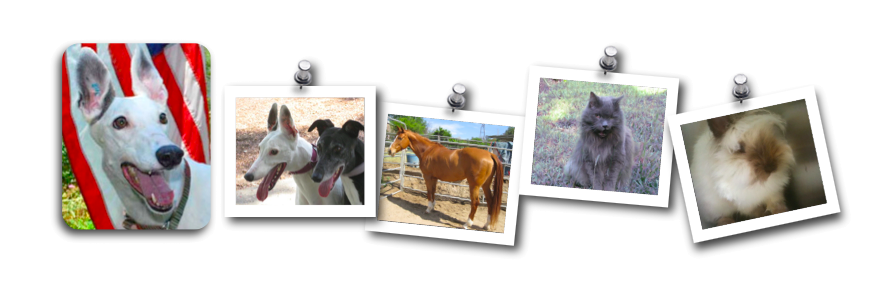Animals need time to adjust to changes. With TLC and consistant gradual changes they will usually do fine. Be patient.
Payson Roundup
Animals need time to adjust to change
Chandra Cushman
October 22, 2010
Here at the Humane Society of Central Arizona, we experience change on a daily basis. The change we see here, though, is positive. It sometimes is not something we notice until a few months have passed; it’s slow change.
Like when a young dog comes in and is so afraid we have to carry him from the car back to the kennel. Then, a few months later, it’s like we are working with a completely different dog.
As time goes by, these fearful dogs begin to trust and love us. They make great strides with manners, socialization and showing their love and appreciation. I’ve had previous adopters tell me that the shelter animal they’ve adopted showed them more affection than previous animals from their past that they bought from a pet store or purchased from a breeder.
Some animals need some time to adjust to the new change in their life after being adopted. With some, shelter life is all they’ve ever known. That’s why the benefits always outweigh the struggles when it comes to adopting a shelter animal. So let me ask you this: Is it time for a positive change in your life?
Many of you know of the newest addition to our family here at the Humane Society of Central Arizona. Her name is Sarah Hock and she is our new executive director. I wanted to sit down with Sarah and ask her some questions that were fun and would help you get a better feel of who she is. So, here we go!
Q: If you could be a dog, what kind would you be?
A: “I wouldn’t, I would be a cat. Cats are intelligent, independent and mischievous.”
Q: What are your immediate and long-term goals for HSCAZ?
A: “My immediate goal is to serve all animals in HSCAZ’s care to the best of our ability. My long-term goal is to do more education and outreach programs in the community in regards to preventative health care, pet responsibilities and the joys of adopting a shelter animal.”
Q: What makes you proud to be part of the family here at HSCAZ?
A: “The opportunity to work with such dedicated staff and volunteers here at HSCAZ.”
Q: What are your favorite music bands?
A: “Jackson Brown, David Bowie, The Pixies and The Constantines.”
Q: How many animals do you have?
A: “I have six cats, all are rescues. The latest addition is a kitten I bottle-fed from just 2 days old.”
Q: What is a common misconception about shelter animals?
A: “That if they are in the shelter system, there must be something wrong with them. We have plenty of healthy, happy animals that have simply had the misfortune of losing their home.”
Q: Aimes is our featured pet of the week. What do you think the ideal home for him would be?
A: “A patient, understanding home that will be willing to work with him. Someone who understands where he came from. Preferably a home with other dogs so he can play and continue to learn how to be a dog.”
AIMES
Aimes came in to the shelter on May 4, 2010. He was a nervous wreck and had to be carried from the car to the kennels in back because he refused to walk on a leash. He was shaking in fear, so thin his ribs were showing and covered in dirt and poop. His future didn’t look too bright, but we wanted to give him a chance.
After just a few days he started to come to the front of the kennel, showing interest in us. I remember washing him off to get rid of all the dirt and seeing that he was actually white underneath, not brown.
We slowly gained Aimes’ trust. With each day that went by we saw more and more progression with him. We had to put a harness on him to get him to go on walks because he refused to walk with just a leash and collar. Our dedicated volunteers were patient while they taught him how to walk on a leash; he probably never had before he came here.
Aimes really started to perk up once he got to go to the play yard and play with the other dogs. He was a little confused at first, not knowing how to play or interact with other dogs, but he sure got the hang of it quick.
Aimes is now house-trained and does well with all dogs and even children. We have taken him to mobile adoption events in the Valley and he does just fine in public. Since he is a Harrier hound mix, his nose tends to lead him while he is on walks and in the yard, so a decent-sized yard and plenty of activity is something he will definitely need.
Watching some of these animals come in and do a complete 180 is something we take pride in. If they can do it for us, they can certainly do it for you, just give it time. Remember, change is good.
Come down and meet our adoptable animals at 812 S. McLane Road. October is the American Humane Association’s Adopt-A-Dog Month®. For one more week, all dog adoption fees are just $25 at the Humane Society of Central Arizona. We have a special discount fee for our senior animals and our Lonely Hearts Club members of just $15. Adult cats are $50 and kittens are $70.
Don’t forget to vote for us every day during the Holiday Shelter Challenge at www.theanimalrescuesite.com!
Originally published at: http://www.paysonroundup.com/news/2010/oct/22/animals-need-time-adjust-change/

